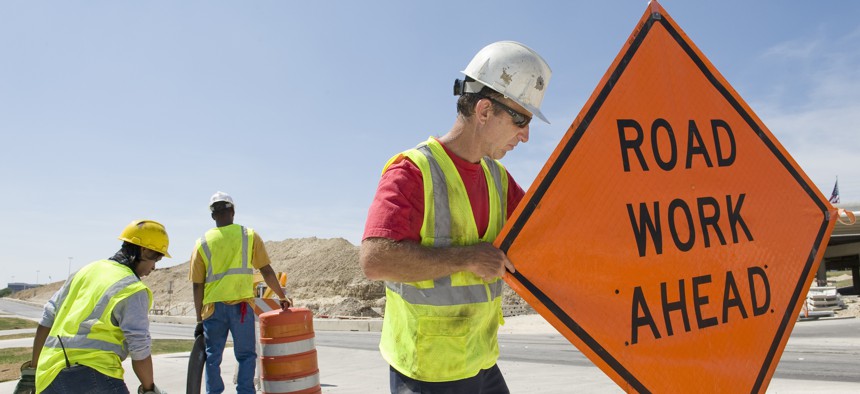Infrastructure remains a top priority for cities

Yellow Dog Productions via Getty Images
According to an analysis of State of City addresses, mayors’ top focus for the third straight year are the nation’s road, bridges and water systems. Finances and public safety followed closely behind.
With billions of federal dollars in the hands of local officials to fix the nation’s roads, bridges and water systems, it is no surprise that infrastructure is at the top of many mayors’ agendas.
In fact, 37 mayors devoted about one-third of their State of City addresses to improving infrastructure, according to an analysis last week by the National League of Cities. That’s about twice as much time as mayors spent talking about the next highest priority: managing budgets. Mayors spent about 17% of their speeches on finances as the nation is facing an uncertain economic future.
The mayors also spent 12% of their annual addresses discussing improvements to public safety, 11% on economic development, 9% on health and human services and 8% on the shortage of affordable housing.
Priorities remained largely unchanged compared to the prior five years, though mayors spent more time this year addressing public dissatisfaction with policing and crime and a little less on housing.
Infrastructure has been among the top four priorities for the last five years and has received top billing in State of City addresses for the past three years, according to the study. NLC credited the 2021 bipartisan infrastructure law for the issue’s dominance, as well as the fact that the nation’s roads and bridges, freight rail and ports, electrical grids and broadband networks are aging and in need of repair.
“Mayors have once again made it clear that infrastructure is a top priority, as they see a pressing need to upgrade roads and bridges, water systems and broadband access,” Clarence Anthony, the group’s CEO and executive director said in the report.
Mayor Harold Weinbrecht of Cary, North Carolina, for example, highlighted in his annual address several projects the city will be doing, including widening roads, improving bike lanes, installing bus stop security lighting and building pedestrian bridges.
Several mayors have also discussed investing in infrastructure to address climate change.
Everett, Washington, Mayor Cassie Franklin mentioned in her State of the City address that the city will “fully transition […] buildings away from fossil fuels when possible.” And Kingston, New York, Mayor Steve Noble said his city plans to install solar panels to power park facilities and city hall.
Mayors devoted more time to city finances this year as consumer spending has slowed due to higher prices and interest rates.
“Cities need to prepare for the possibility of a recession and continued inflation by exploring other sources of revenue, adopting more conservative budgets, building up rainy-day funds, and diversifying their revenue sources,” the report said.
Mayor Neal McIntyre of Fernley, Nevada, said he would continue the city’s long-standing fight to get a larger share of the taxes the state collects from the sales of products like cigarettes, liquor and property.
Meanwhile, public safety was a hot topic. It had previously been the seventh most discussed issue by mayors in their addresses in 2019. But since George Floyd’s murder by Minneapolis police the following year, it has been in the top five issues in State of the City addresses, according to the report.
Port Jarvis, New York, Mayor Kelly Decker discussed “a rather innovative approach” in his address when talking about the use of a new technology called BolaWarp, according to the report. The product shoots a cord to restrain and immobilize fleeing suspects, “significantly decreasing the chances of lethal and fatal injuries.”
Housing had been the third highest issue mayors talked about in 2020. But in the years since, it has dropped below finances and public safety. That’s despite the fact that housing still remains a major issue, the report said, noting that Freddie Mac estimates the nation is 3.8 million housing units short of meeting its current demand. The shortage is expected to grow to 5.5 million units by 2030.
Kettering, Ohio, Mayor Peggy Lehner, for instance, mentioned in her address that the city will be building a 50-unit, $11.5 million affordable housing apartment building as well as affordable housing for those aged 55 and older. San Diego Mayor Todd Gloria discussed how the city will be buying a motel to house homeless people.
Homelessness also dropped in terms of how much time mayors devoted to the topic in their speeches. The National League of Cities did not immediately respond when asked why that might be.
But the report did highlight city efforts on economic development, particularly comments by mayors on improvements to parks and open spaces. Ninety-two large cities and counties have used part of their American Rescue Plan Act dollars on parks and open space in an effort to attract and retain residents. The report pointed to another study by the National Recreation and Park Association and George Mason University’s Center for Regional Analysis that found 72% of communities use images of urban parks, public spaces, outdoor amenities, and recreational and cultural facilities in their economic development marketing materials.
Kery Murakami is a senior reporter for Route Fifty, covering Congress and federal policy. He can be reached at kmurakami@govexec.com. Follow @Kery_Murakami






